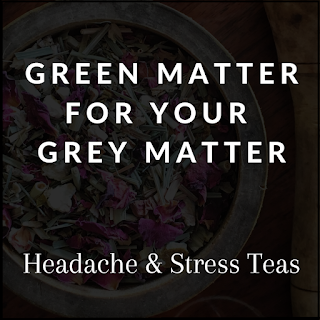Gosh is it EVER headache season. Whether it's energy drain hangover, a renewed commitment to reading five million books a week (hello, eye strain), back-to-school blues or sugar withdrawal, I've got you covered with hella plants to help fix what ails ya.
Of course herbal medicine has its strengths and flaws. Very few reliable studies have been done on efficacy of medicinal herbs due to lack of funding and wild fluctuations of nutrient levels over the course of the plant's life cycle (not to mention what time of day it was picked, where it was grown, what part of the plant is being used, etc.) and I will never claim to be a doctor or a miracle worker. That being said, hopefully some of the plant knowledge I have acquired in my lifetime will be of use to you. Give these remedies a try and let me know in the comments what worked for you!
Green and Black Tea First on our list of of headache tea recommendations is just straight-up tea. Green and black tea are both high in L-theanine, an amino acid that helps with non-drowsy relaxation. Bonus points for caffeine, a natural vasodilator. When your headache is from stress, L-theanine is your friend for sure. If high blood pressure is hurting you, caffeine can help get those blood vessels open to let your brain breathe again. (Check out our green and black tea selections for lots of tasty choices!)
Chamomile You may have expected to see this one here. In addition to being tasty and cozy, chamomile functions as a delicate sedative due to a flavonoid apigenin which, according to this Mol Med chamomile study, binds to benzodiazepine receptors in the brain to reduce muscle tension and seizure tendencies. Grandma was on to something with that bedtime chamomile tea. (Try our herbal blend of chamomile and sage, Mrs. Bennet's Nerve Tonic, for seriously stubborn headaches.)
Sage & Rosemary Common garden sage stimulates blood circulation and digestion. Rosemary has circulatory, anti-inflammatory and analgesic (pain numbing) applications. While powerhouses on their lonesome, they work particularly well in conjunction with one another! (Our favorite soothing sagey brew is Brother, Captain, King, or try the Memory Booster if rosemary is your flavor.)
Allspice & Clove Speaking of analgesics, allspice and clove are both frequently overlooked members of the pain reduction and anti-inflammatory spice family. Like rosemary, clove and allspice can numb pain receptors to offer both relief and cozy warming comfort (Our Satyr's Song is heavy on the clove and full of playful woodland flavor)!
The Whole Dang Mint Family There are so many more yummy relaxation herbs than many of us know about! Sure, you've got your peppermint, spearmint, chocolate mint, orange mints, etc. This family also contains stress and tension relief rock stars catnip (yes, like the stuff they sell at pet stores), holy basil (aka tulsi), lemon balm, the aforementioned sage & rosemary, thyme, lavender, basil, savory, oregano and marjoram. So basically all of your aromatic culinary herb garden. Peppermint and its cousins contain a range of oils, flavonoids and other compounds that contribute to muscle relaxation and clearing of the sinuses, which can relieve behind-the-eyes headache pain. Honestly, just pick a mint family member that most appeals and brew it on up! You'll be feeling better in no time. (My personal go-to headache tea is our old standard, Green Ginger Mint.)
Lemon Verbena For a super aromatic relaxation experience, check out this Victorian era fave. Lemon verbena is a brightly fragrant perennial shrub native to South America with a long history of folk medicine use. Applications include treating anxiety, sleeplessness, colds and fevers, puffy eyes and skin conditions. Miracle herb! (Quiet the Mind is a verbena-heavy rooibos blend designed to clear out the brain clutter and relax without making you drowsy. If you're more of a lavender-and-lemon fan, check out the Alice in Wonderland inspired herbal, Very Good Advice.)
Passionflower Another native of the Americas, passionflower has been shown to boost GABA amino acid levels in the brain, leading to a decrease in anxiety, stress and tension. All good stuff! You may expect passionflower to taste sweet and juicy like the fruit it bears, but I can tell you from a LOT of personal experience that this is a grassy flavored flower, verging on bitter. If you are making passionflower tea, we recommend adding a pop of citrus to cut through the earthy notes and make it more pleasant to drink. (If passionflower sounds like a party to you, check out our ever-beloved Get Happy!)
Scullcap Yes, I'm calling out another member of the mint family even though we've covered them as a category. There's a reason for this, and that is because scullcap (also spelled Skullcap) is a rockstar relaxant for your muscles and your nervous system. Especially effective for your stress levels and anxiety when combined with complementing herbs passionflower and yarrow, an herbal mood-booster. (For that power combo shot of scullcap, passionflower and yarrow PLUS peppermint and tulsi, see once again our winter blues blend, Get Happy.)
These are just a few of the myriad plant options to keep in your medicine cabinet. What's your go-to tea to sooth an achey head and jangled nerves? Let me know in the comment section.
Enjoy some relaxing tea and have a wonderful day!
-Friday







